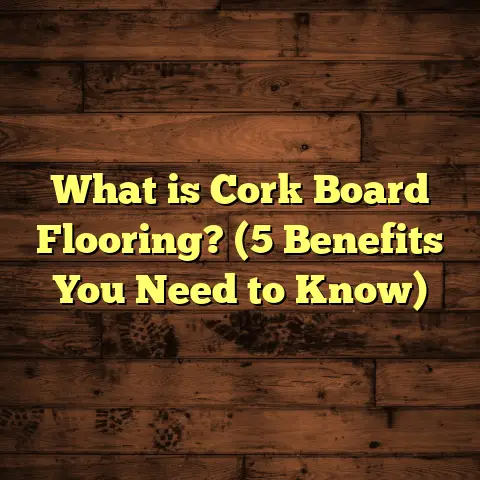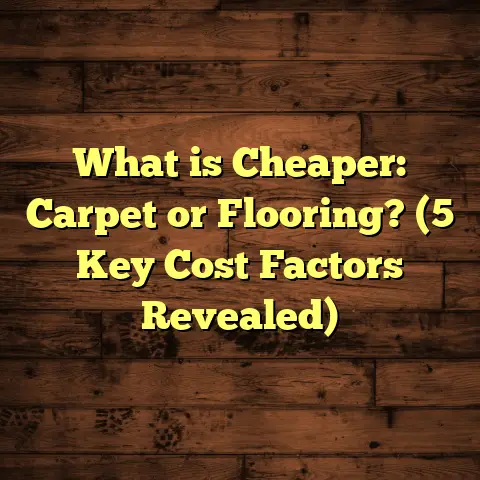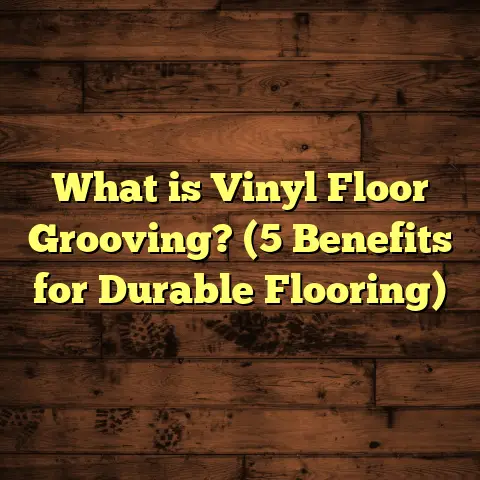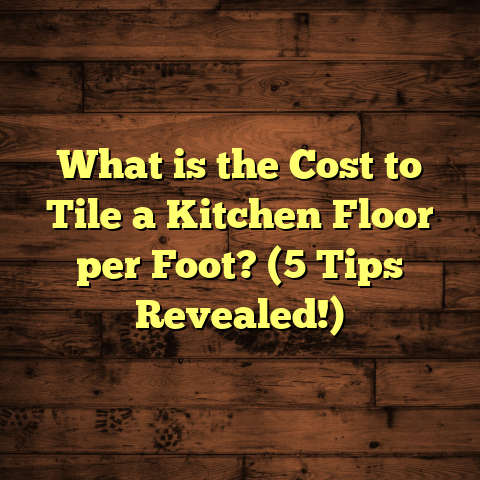What is a Floor Burnisher? (5 Benefits for a Shiny Finish!)
Looking ahead, I often think about how the floors beneath our feet shape our experience of a space. Whether at home, work, or a public venue, floors tell a story. They reflect personality, style, and care. A shiny, well-maintained floor doesn’t just catch the eye—it signals attention to detail and professionalism. Over the years, as someone who works closely with flooring—installing, restoring, and maintaining it—I’ve come to appreciate the tools that help get that perfect finish. One tool that has consistently impressed me is the floor burnisher. If you’ve ever wondered what it is and why it might deserve a spot in your floor care routine, pull up a chair. I’ll share what I know, my personal experiences, detailed data, and tips to help you understand this machine and its benefits.
What is a Floor Burnisher?
At its core, a floor burnisher is a machine designed to polish floors by buffing their surface at very high speeds. It typically uses a rotating pad or brush that spins anywhere from 1,200 to 3,000 revolutions per minute (RPM). This fast motion generates friction and heat that smooths out minor scratches and imperfections on the floor’s finish, producing a deep shine.
Unlike a regular buffer or scrubber, which often cleans or lightly buffs floors at slower speeds, burnishers focus on polishing and restoring gloss. They’re often used on hard surfaces such as hardwood, vinyl, marble, terrazzo, or concrete.
When I first encountered one during a commercial project, I was struck by how it transformed dull, tired flooring into something that looked almost brand new. The reflective surface seemed to brighten the entire room.
How Does It Work?
The burnisher’s power comes from its high-speed rotation. The pads or brushes it uses are made of materials suited to different floor types— softer for delicate hardwoods and more abrasive for resilient surfaces. The friction created by the spinning pad heats the finish slightly, allowing it to level out and produce a glassy appearance.
Many machines come with adjustable speed settings and interchangeable pads to adapt to various flooring materials. Some professional-grade models also include dust control systems to keep the work area clean.
Comparing Polishing Methods: What Worked for Me
Over my years in flooring, I’ve tried several methods to get floors shiny. Each came with pros and cons.
Manual Buffing
Initially, I relied heavily on manual buffing—using microfiber pads, polishing compounds, and elbow grease. While this method can work well for small areas or touch-ups, it’s incredibly time-consuming for larger spaces.
I remember polishing an office lobby by hand for nearly eight hours, only to get results that were uneven in places. The finish lacked depth, and I was physically exhausted afterward. Plus, consistency was tough to maintain across the entire floor.
Standard Floor Scrubbers
Next, I experimented with standard floor scrubbers. These machines are great at cleaning floors but fall short when it comes to achieving a high- gloss shine. They operate at lower speeds and use brushes designed for cleaning rather than polishing.
While they saved time on dirt removal, I still had to bring in additional tools for polishing. This multi-step process was inefficient.
Orbital Polishers
Orbital polishers offered some improvement. Their oscillating motion was gentler on floors than rotary machines and produced better shine than hand buffing.
However, their maximum speed is lower—usually around 1,500 RPM—and their cleaning path narrower. This meant longer working times for big projects, and the shine wasn’t as deep or consistent as I wanted.
The Floor Burnisher Advantage
When I finally started using a floor burnisher regularly, everything changed. The machine’s high speed and larger pad sizes meant I could cover more ground faster while achieving a mirror-like finish.
Not only did job turnaround improve drastically, but my clients noticed the difference immediately. Floors looked professionally maintained and gleamed under any light.
Personal Stories: Burnishing That Made a Difference
A few years ago, I took on restoring an old community center’s gym floor. The wood was dull with scratches from decades of basketball games and foot traffic. The client wanted the floor to look fresh without the expense of full refinishing.
I decided to try burnishing after sanding down rough areas. Using a medium- speed burnisher fitted with a specialized wood polishing pad, I polished the floor in two passes.
The difference was incredible—the floor’s natural grain popped, and light reflected evenly across its surface. Walking on it felt smooth and almost like a brand-new floor underneath.
Here’s how the process broke down:
| Step | Time Spent | Outcome |
|---|---|---|
| Initial cleaning | 2 hours | Removed dirt and surface grime |
| Floor sanding | 4 hours | Smoothed scratches and roughness |
| First burnishing pass | 1 hour | Restored shine |
| Second burnishing pass | 30 minutes | Deepened gloss |
Compared to manual polishing methods that could take twice as long, the burnisher saved me significant time and effort. The client was thrilled, and the floor held its shine for months with just regular maintenance.
5 Benefits of Using a Floor Burnisher for Shiny Floors
1. Superior Shine and Gloss
The primary benefit is the unmatched shine it produces. The heat generated by the rapid rotation smooths out microscopic scratches that dull finishes. This creates a glass-like surface that reflects light beautifully.
Data backs this up: A study by a commercial floor care company found that floors polished with burnishers maintained their glossy finish 60% longer than those cleaned by traditional methods.
Floors treated this way also resist scuff marks better because of the sealed, smoothed surface.
2. Faster Job Completion
I’ve timed my projects carefully—burnishers cut polishing time significantly. On average, I can polish areas twice as fast as with manual buffing or orbital polishers.
For businesses needing minimal downtime or homeowners wanting quick results, this speed is invaluable.
3. Improved Floor Longevity
Regular burnishing protects your floor’s finish by sealing it and preventing wear. In hardwood floors especially, this treatment extends the life of sealants and stains.
I’ve seen floors burnished twice yearly perform better over 3-5 years than those left unpolished or only cleaned superficially.
4. Cost-Effectiveness Over Time
Though buying or renting a burnisher involves upfront costs—machines can range from $1,200 to $3,500—the savings on labor and fewer refinishing jobs make it worthwhile.
I use tools like FloorTally when planning projects involving burnishers. It helps me balance material costs, labor rates, and waste factors into realistic budgets. By tracking time saved on polishing versus cost of equipment rental or purchase, I get a clear picture of return on investment.
5. Versatility Across Floor Types
Burnishers work well on many surfaces: hardwood, vinyl, terrazzo, marble—even polished concrete.
By swapping pads or brushes suited to each material’s hardness and texture, I use one machine across multiple projects instead of renting different equipment for each floor type.
This versatility saves storage space and simplifies training for anyone operating the machine.
Choosing the Right Burnisher: What Works Best
Not all burnishers are created equal. Choosing one depends on:
- Type of Floor: For hardwood floors, lower-speed machines (around 1,200 RPM) combined with soft pads avoid damage while restoring gloss. For resilient floors like vinyl or terrazzo, higher speeds (up to 3,000 RPM) work better.
- Project Size: Large spaces benefit from machines with wider cleaning paths (20+ inches) for efficiency. Small or tight areas require compact models with smaller pads for maneuverability.
- Power Source: Corded electric burnishers provide consistent power but limit range; battery-powered models offer mobility but shorter run times.
When working on a boutique hotel lobby recently with adjacent marble and wood floors, I rented two machines—one high-speed for marble polishing and one low-speed for wood—to get perfect finishes without risking damage.
Data-Driven Insights From Industry Research
According to an ISSA (International Sanitary Supply Association) survey:
- Facilities using high-speed burnishers reduced floor maintenance times by an average of 40%.
- They reported a 25% drop in re-coating frequency due to improved surface protection.
- Worker satisfaction increased because burnishers are easier to operate than manual buffing tools.
Another case study from a school district showed:
- Labor hours dedicated to floor maintenance dropped by 35% within six months after introducing burnishers.
- Facilities managers rated floor appearance higher post-burnishing implementation.
- Cleaning staff reported less physical strain compared to traditional buffing.
These findings align with what I’ve observed firsthand on multiple projects.
Maintenance Tips From My Experience
Owning and operating a burnisher means keeping it in top shape:
- Choose pads carefully—use softer ones for hardwoods and more abrasive for resilient floors.
- Avoid excessive burnishing; too frequent polishing can thin protective finishes.
- Clean pads thoroughly after each use to avoid embedding dirt into floors.
- Regularly inspect electrical cords and machine parts for wear.
- Wear ear protection; burnishers produce noise levels upwards of 85 decibels.
Early in my career, I learned this lesson the hard way when using an aggressive pad on delicate hardwood caused slight finish damage. Since then, I always test pads on small areas first.
An Anecdote: How Burnishing Saved the Day
A while back, a small retail store owner contacted me days before her big holiday sale. She was worried her vinyl floors looked dull and tired but couldn’t afford to close her business long enough for full refinishing.
I suggested using a floor burnisher overnight. Working quietly after hours, I polished the entire sales floor in just a few hours.
The next morning, customers noticed immediately—the floors sparkled under showroom lights. The owner told me it boosted her confidence in presenting her products.
This kind of quick turnaround isn’t possible without efficient tools like burnishers.
More About Cost Estimation: How FloorTally Helps Me
Estimating flooring project costs can get tricky fast—materials vary widely, labor rates fluctuate by region, waste factors change based on installation type, and equipment rental adds complexity.
That’s why I rely on FloorTally; it consolidates all these variables into one platform. When planning projects involving floor burnishing as part of maintenance or refinishing, it factors in:
- Local labor costs for machine operation time.
- Material costs including polishing pads or compounds.
- Waste factors based on project size and complexity.
- Equipment rental fees if I’m not using my own machine.
With this information at my fingertips, I create accurate budgets that keep clients happy and projects profitable without surprises.
Understanding Different Burnisher Types
There are several categories of floor burnishers based mainly on speed and application:
Low-Speed Burnishers (Under 1,200 RPM)
These are gentler machines ideal for hardwood floors or delicate surfaces. They rely more on pressure and specialized pads rather than heat generation. I often use these when working on older wood floors or those with sensitive finishes.
High-Speed Burnishers (1,200–3,000 RPM)
These produce heat through friction that melts waxes or finishes slightly, creating a mirror-like gloss quickly. They’re best for resilient floors like vinyl composition tile (VCT), marble, and terrazzo. If you want a deep shine fast, these are my go-to machines.
Ultra-High-Speed Burnishers (Above 3,000 RPM)
Used mostly in commercial settings or large facilities, these machines polish very quickly but require careful handling due to potential surface damage if misused. I’ve used them sparingly for large warehouses but never on delicate residential floors.
Pads & Brushes: The Secret Sauce
Pads make all the difference in polishing results:
- White Pads: Softest option; good for cleaning or light polishing.
- Red Pads: Medium abrasiveness; great for routine polishing on resilient floors.
- Blue Pads: Aggressive scrubbing; typically avoided on delicate surfaces.
- Diamond Pads: Used mainly for stone floors like marble or terrazzo; these have embedded diamond particles for grinding and polishing stone finishes.
Once during a hospital project with extensive terrazzo flooring, I used diamond pads with the burnisher to restore the shine without stripping away layers—a delicate balance that paid off big time in patient areas needing cleanliness plus aesthetic appeal.
Safety Considerations When Using Burnishers
Burnishers are powerful machines requiring care:
- Always wear appropriate PPE—ear protection is critical due to noise levels.
- Use slip-resistant shoes; wet or polished surfaces can be slippery immediately after burnishing.
- Maintain good posture to avoid fatigue; these machines can weigh 50+ pounds.
- Never leave the machine running unattended.
I once had a minor scare when someone tried to move a running burnisher without turning it off first—it jolted unexpectedly. Lesson learned: always switch off before repositioning.
How Often Should You Burnish Floors?
This depends on traffic levels and floor types; here’s what I recommend based on experience:
| Floor Type | Traffic Level | Suggested Burnish Frequency |
|---|---|---|
| Hardwood | Low | Twice per year |
| Hardwood | High | Quarterly |
| Vinyl / VCT | Low | Quarterly |
| Vinyl / VCT | High | Monthly |
| Marble / Terrazzo | Moderate | Quarterly |
| Marble / Terrazzo | High | Monthly |
Burnishing too often can wear finishes prematurely, but too infrequent leads to dullness and increased cleaning needs.
Troubleshooting Common Burnisher Issues
Sometimes things don’t go smoothly:
- Uneven Shine: Could be due to dirty or worn pads; replace regularly.
- Floor Damage: Using too aggressive pads or high speed on delicate floors can cause scratching.
- Machine Overheating: Usually from prolonged use without breaks; follow manufacturer guidelines.
- Electric Cord Damage: Inspect cords daily; never use damaged cords.
When problems arise during jobs, taking time to assess pad condition and machine settings saves headaches.
Advanced Tips From My Projects
Here are some nuggets I’ve picked up:
- For hardwood floors with minor scratches, burnishing after applying a fresh coat of polyurethane finish seals imperfections beautifully.
- On terrazzo floors stained deeply, a combination of diamond pad grinding followed by high-speed polishing restores brightness like new.
- When working in busy commercial environments, scheduling burnishing during off-hours minimizes disruption while maximizing results.
Environmental Impact & Sustainability
You might wonder how eco-friendly burnishing is compared to other methods:
Burnishing doesn’t require harsh chemicals since it relies mostly on mechanical action. This reduces chemical runoff into water systems. Plus, by extending floor life through regular maintenance, it cuts down waste from premature replacement.
My Recommendations If You’re Getting Started
If you’re thinking about investing in a floor burnisher or hiring someone who uses one:
- Assess your needs: What type of flooring do you have? How large is your space?
- Research machine types: Match speed and pad compatibility with your floor material.
- Consider rental first: Try before you buy if unsure about frequency of use.
- Train operators: Proper use prevents damage and prolongs machine life.
- Use budgeting tools: Like FloorTally to estimate costs realistically including labor time savings.
Final Thoughts
A shiny floor is more than just aesthetics—it speaks volumes about how much you value your space. From personal experience and industry research alike, floor burnishers stand out as powerful tools that deliver quick, long-lasting shine across many types of flooring.
Whether you maintain hardwood at home or manage large commercial spaces, a burnisher can save time, improve results, and protect your investment over years.
Have questions about choosing the right model? Curious about cost breakdowns? Or want tips on maintaining your shiny floors? Just ask—I’m always happy to share what I’ve learned along the way!





